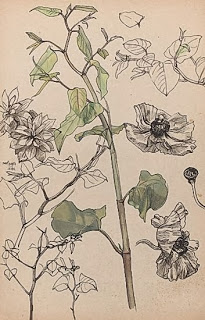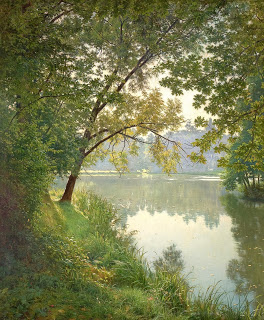Research Point 1 (Masters of Detail)
Charles Mahoney 1903-1968
 Polygonum and Anenome de Caen, 20th century
Image from http://www.lissfineart.com/picture/96
Polygonum and Anenome de Caen, 20th century
Image from http://www.lissfineart.com/picture/96
I chose this piece as it contains a flower that I also used as a subject in my line drawing of a still life group a bit later in this section of the course. In my line drawing I used hardly any lines to show the detail of the petals, as I wanted them to look soft. However, Mahoney used a lot of lines to show the creases and crumples and still managed to get a soft effect. His use of line is quite extraordinary as it is very precise, and where he only uses a few lines he manages to suggest the form exactly. He uses both curved and straight lines when drawing branches and stems, giving them a very realistic feel. His use of tone and colour is quite simple but is highly effective, as the shadows, curves and markings on the leaves are extremely accurate.
Henri Fantin-Latour 1836-1904
 White Roses, Chrysanthemums in a Vase, Peaches and Grapes on a Table with a White Tablecloth, 1867
Image from http://tinyurl.com/olxs5d9
White Roses, Chrysanthemums in a Vase, Peaches and Grapes on a Table with a White Tablecloth, 1867
Image from http://tinyurl.com/olxs5d9
In this work, there is a kind of grainy effect, however it does not obscure the details of the objects in the still life. The use of tone makes it so that you can see every single petal and leaf of the roses and chrysanthemums. Even though the grapes are nearly black, you can see the edge of each one, and the small highlights really give them a three dimensional look. The slight fold in the corner of the tablecloth is very subtley presented. Every object has seems to have so much detail. I always think that detail is achieved using small marks, but if you look closely you can see that some of the marks used are actually quite big.
Research Point 2 (Artists with Contrasting Styles)
Zeana Romanovna
(Please click link to view image)
I found this artist by mistake when looking for an artist with an expressive style and really loved this painting. Like in John Ruskin's Study of a Sprig of a Myrtle Tree, the edges are not exactly defined, and there is an almost blurry look to the picture. However the use of colours is much different. The colours here are a bit psychadelic and probably nothing like they were on the object being painted, but the shape and beauty of the flowers is presented really beautifully. There is enough detail to show the stems and petals, but the brush strokes are very big and almost messy. The style is very relaxed and fun, but the placement of the strokes and the colours used suggest the form and tone accurately.
Henri Biva
 Matin à Villeneuve (From Waters Edge), 1905-06
Image from http://tinyurl.com/ltdv8jb
Matin à Villeneuve (From Waters Edge), 1905-06
Image from http://tinyurl.com/ltdv8jb
The colours in this piece are much more natural and realistic. The strokes are much smaller, which allows for finer details to be defined. The piece is less fun, but more realistic. There is a great deal of detail, for example the blades of grass are defined individually, and the leaves of the bushes and the trees, and even the spaces between the leaves are defined to show the sky behind. The objects in the foreground are not the only things that are drawn precisely, as you can see that on the reflection of the background on the water, the form of the trees is presented accurately, and even the slight ripples of the water are present. The highlights and shadows on the leaves and on the bark of the tree are very realistic.
Research Point 3 (Ben Nicholson)
Why does he simplify still life forms and negative space and superimpose them on the Cornish landscape?
Nicholson's art allowed him to 'explore his interest in uniting objects in the foreground with those in the background' (richardgreen.com). You can tell that Nicholson was really inspired by the landscape as it is present in all of his work.
My favourite work of Ben Nicholson is Window in Cornwall (1946). I like it because it is between the stage where he drew landscapes and still life separately, and the stage where he superimposed the still life objects onto the landscape. It also reminds me of family holidays to Cornwall and looking out at the sea.
Research Point 4 (Depictions of Animals by Renaissance Masters)
Leonardo Da Vinci
Da Vinci's animal drawings focus on the shape, structure and pose of the animal, with little detail on the actual creature other than base shadow. In the drawings I have seen, Da Vinci has not drawn long haired or very texture animals, so it looks as though he does not depict fur or texture on the animal, but focuses more on the shape and proportions. This might be the case only on the two drawings I have selected though (a short haired dog and a horse), as the texture of the horses mane is very realistic.
Albrecht Durer
You can see in Durer's Rhinoceros and Young Hare that he takes into account the texture of the animal.
The fur of the hare is very realistic, it looks fluffy and has a sheen to it. The eyes are also very realistic and have a glossy look to them. The poses he has the animals in are very interesting, and the structure is accurate even with the, on the hare, fur details on top you can see where the legs are bent and where the skin folds.
The rhinoceros' skin looks armoured, almost like plate mail, and has a circular pattern over it. The texture of the horn is clearly rough.
Research Point 5 (George Stubbs)
George Stubbs (1724-1806)
By studying the anatomy of horses, cats and dogs, Stubbs was able to understand the different poses and motions the skeleton and muscles of the animal is capable of making, with anatomically correct pivoting and joint movement.
Study by George Stubbs of a horse's skeleton
Study by George Stubbs of a horse's skeleton with some muscle
This helped him draw horses accurately in a variety of dynamic poses - galloping, walking, and standing. Durer and Da Vinci both drew motionless animals. The benefit of the skeletal drawings is clear when looking at Stubbs' pictures of horses with lions, as the horses are in unusual positions but they are drawn perfectly - as if the horses posed for the drawings in those positions. The way he has drawn the muscles is incredible.
When you compare his drawings of the lions to those of the horses, you can see that he has a better understanding of the figures of horses. The horses are always confidently presented as the main figure in the drawing, basked in light, whereas the figure of the lion will be obscured by shadow or partially hidden behind the horse. It looks as though he probably used his studies of cats to draw the lions, as I don't think he would've had any access to lions. The bone and muscle structure of cats is very similar to lions, and they have a similar stance. The lions look quite small - probably to show how majestic the horse is.





































